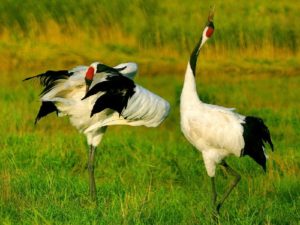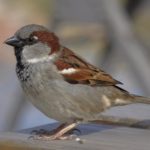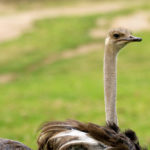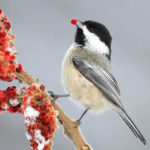Japanese crane
 Unfortunately, people do not often think about the future. And when they lose something valuable and unrecoverable from nature, as a result of improving their lives, they shrug their shoulders or push the blame on each other. In great trouble is one of the most beautiful birds in appearance and behavior – the Japanese crane.
Unfortunately, people do not often think about the future. And when they lose something valuable and unrecoverable from nature, as a result of improving their lives, they shrug their shoulders or push the blame on each other. In great trouble is one of the most beautiful birds in appearance and behavior – the Japanese crane.
This species has long been listed in the International Red Book. And now the number of individuals of this species on the whole Earth does not exceed two thousand.
The cause of the disaster of such a rare bird is its way of life. And to be more precise, the place of its permanent habitat. Now swamps are constantly draining in order to carry out a new branch of roads, build a new city, etc. And by this very people destroy many different types of animals, insects, fish, reptiles and plants.
The Japanese crane lives mainly in Japan – from which comes the characteristic name in swamps or marshy meadows. But it is also found in Russia and China.
Very charming view of this bird. The feathers, painted in bright white, gradually move along the tips of the wings and on the tail to black. And on the very top there is a red cap.
No wonder the Japanese, who are considered the most sophisticated connoisseurs of beauty in the world, noticed this bird and attributed to it one of the most important symbols in their culture. For them, this bird symbolizes what each person aspires to. This is longevity and prosperity.
Despite such a cruel life, the Japanese crane does not despair and continues the beautiful traditions of its ancestors. His dance cannot be compared with anything. When against the backdrop of the sun rolling beyond the horizon, which is reflected in the swamp water, the crane begins its flowing movements as if to the beat of nature’s music. Becoming an unwitting witness to such a spectacle, it seems that this music sounds in our hearts.
But we do not know how to listen to her. Crane movements are accompanied by jumps and instantaneous sinking. Even more majestic view of this give it loose wings. It happens that cranes do not dance alone, but in pairs. And then the dance ends with the flight of two birds side by side over the territory of their habitat. What is remarkable is that dances do not happen only during the mating season. Dance for the Japanese crane is his life.
The crane feeds mainly on marsh food – frogs, small invertebrates, fish, and insects. To see it is very difficult. Firstly, because it is a rare bird, and secondly, because life has taught him to be afraid of people.



























